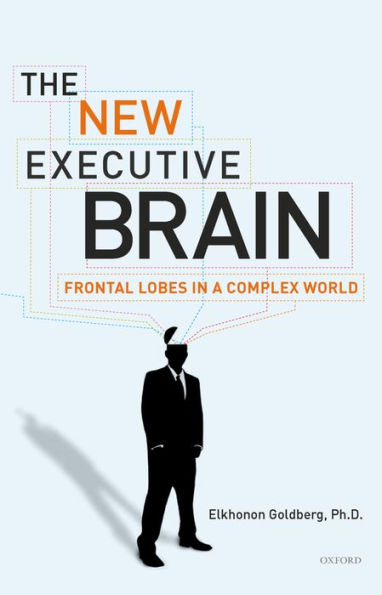
The New Executive Brain: Frontal Lobes in a Complex World

The New Executive Brain: Frontal Lobes in a Complex World
eBook
Related collections and offers
Overview

Product Details
| ISBN-13: | 9780199758500 |
|---|---|
| Publisher: | Oxford University Press |
| Publication date: | 08/12/2009 |
| Sold by: | Barnes & Noble |
| Format: | eBook |
| File size: | 4 MB |
About the Author
Table of Contents
Foreword xiii
1 Introduction 3
2 An End and a Beginning: A Dedication 9
3 The Brain's Chief Executive: The Frontal Lobes at a Glance 20
The Many Faces of Leadership 20
The Executive Lobe 21
4 Architecture of the Brain: A Primer 25
The Microscopic View 25
The Macroscopic View 27
The Command Post and Its Connections 33
5 The Orchestra's Front Row: The Cortex 37
Sounds and Players 37
Noah's Predicament and the Landscapes of the Brain 40
Neuropaganism: Module Madness 43
Cognitive Gradients and Cognitive Hierarchies 48
A Thing Is a Thing 52
A Word to a Thing 54
Cortical Gradients in the Frontal Lobes 56
Autonomy and Control in the Brain 59
6 Novelty, Routines, and Cerebral Hemispheres 63
A False Start 63
The New Paradigm 65
The Evidence 73
Lessons for Clinicians 80
Agnosias and Hemispheres 81
Executive Deficit and Hemispheres 85
7 The Conductor: A Closer Look at the Frontal Lobes 89
Novelty and the Frontal Lobes 89
Working Memory-or Working with Memory? 92
Freedom of Choice, Ambiguity, and the Frontal Lobes 98
Neuroeverything 109
8 Emotion and Cognition 115
The Emotional Frontal Lobes 115
Emotions, Novelty, and Cerebral Hemispheres 122
9 Different Lobes for Different Folks: Decision-Making Styles and the Frontal Lobes 124
The Neuropsychology of Individual Differences 124
Male and Female Cognitive Styles 125
Frontal Lobes, Hemispheres, and Cognitive Styles 129
Cognitive Styles and Brain Wiring 134
Rebels in Small Proportion: Handedness and Novelty Seeking 136
Executive Talents: The S Factor and the Theory of Mind 141
10 When the Leader Is Wounded 148
The Fragile Frontal Lobes148
Frontal Lobe Syndromes 150
Drive and Newtonian Bodies: A Dorsolateral Case Study 153
Plans and "Memories of the Future" 157
Rigidity of Mind 162
Mind Blindspot: Anosognosia 168
11 Social Maturity, Morality, Law, and the Frontal Lobes 171
Orbitofrontal "Pseudopsychopathic" Syndrome and the Loss of Self-Control 171
Social Maturity and the Frontal Lobes 173
Biological Maturation and Social Maturity: A Historical Puzzle 177
Frontal Lobe Damage and Criminal Behavior 179
The Hapless Robber 183
Frontal Lobe Damage and the Public Blindspot 186
12 Fateful Disconnections 189
The Fallen Horseman: A Case Study 189
Schizophrenia: A Connection That Was Never Made 195
Head Trauma: A Broken Connection 198
Attention Deficit/Hyperactivity Disorder: A Fragile Connection 200
ADHD Conquered: How Toby from Down Under Reclaimed Himself 206
Jerky Tics and Ticky Jokes 211
The Cortex and the Striatum 221
13 "What Can You Do for Me?" 228
"Cognotropic" Drugs 228
Aging Brain and Neuroplasticity 232
Neuroplasticity in Action 236
Jogging the Brain 239
History of Cognitive Rehabilitation 244
Brain Plasticity and Cognitive Exercise 245
Cognitive Fitness: Beginning of a Trend 249
14 Breaking and Entering: Inside the Black Box 252
Ramblings of a Dilettante 252
Machine in the Ghost 254
Dopamine, Memory, and the Bicameral Brain 257
Neural Networks and the Bicameral Brain: Models of Novelty-Routinization Dynamics 261
Complicate to Simplify 265
Further Complicate to Simplify: Front-Back, Neocortex-Hippocampi, Left-Right 270
15 Frontal Lobes and the Leadership Paradox 275
Autonomy and Control in Society 275
Autonomy and Control in the Digital World 279
16 Epilogue 282
References and Notes 291
Index 323
